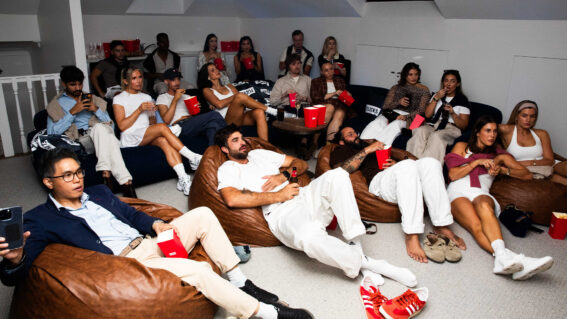Interview: How to Change the World
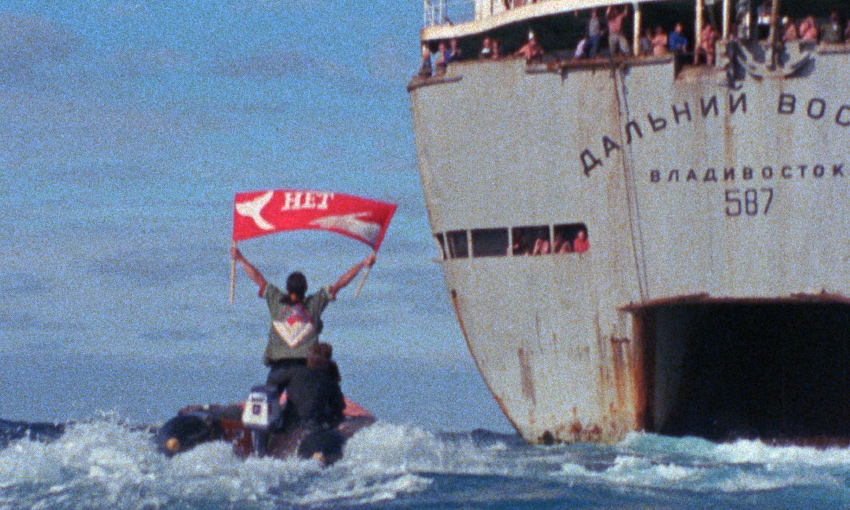
Returning to cinemas after playing the NZ International Film Festival, documentary How to Change the World traces the origins of environmental juggernaut Greenpeace, using a wealth of archival footage to bring to life the outrageous tale of a band of activists who took on vile vested interests. We spoke with director Jerry Rothwell about his film, and his focus on the early period of the organisation and the fascinating characters behind its formation.
FLICKS: Outside my office in Auckland, I’m regularly accosted by people collecting on the street for a variety of charities. They are relentlessly well organised, they are working on commission, they seem to have no connection to the causes they’re really working for, and I can’t think of anything that’s actually more distant from the people that you’ve portrayed in your film, to be honest.
JERRY ROTHWELL: Yeah, that’s interesting.
There must be plenty of people like myself who sort of view Greenpeace as a corporate environmental outfit these days.
That’s an interesting reaction to this film. Lots of people say, “Oh, I didn’t think I was going to enjoy it.” [chuckles] Because I guess to a certain extent, all of us will have that familiarity with Greenpeace and in a way, that view of it as a sort of institution. For me, the journey of making the film started when I realised that there was this treasure of 16mm archive in the Social History Museum in Amsterdam. And then these were the rushes that were shot on board the first boats. And that took me to Bob Hunter’s books. And Bob is, you know, the first President of Greenpeace, but the most uncorporate President you could imagine. And his writings would be funny and honest and self-critical, which is why I used him as the kind of main narrative voice in the film. And then from there I started making contact with the family members. And pretty much everyone really wanted to be a part of that. I think it’s a story that they’ve told in different ways in the past, but they brought to it an incredibly honesty, I felt. It was maybe to do with their age, I don’t know. That you get to the point where you just want to set down what you think happened.
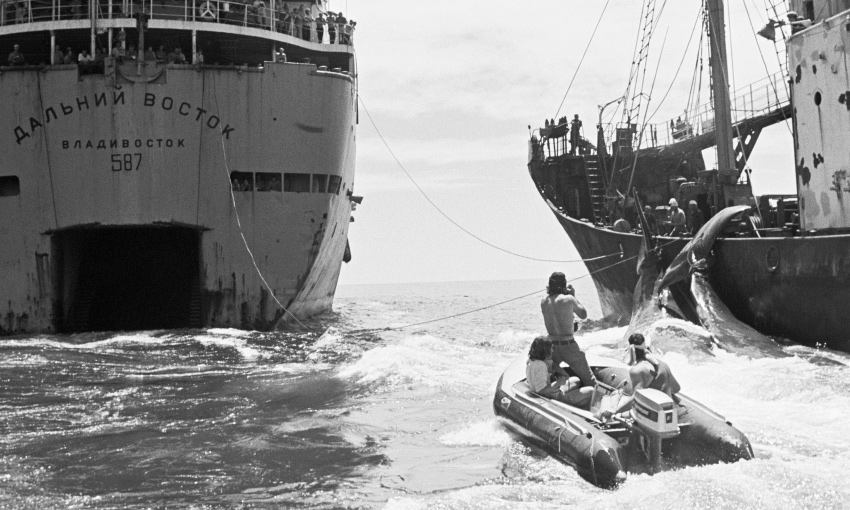
My comments about people collecting on the street – that’s obviously a cynical, city-based attitude, and it doesn’t really betray my attitude towards Greenpeace as a whole, but I think it shows how far it’s come from that beginning.
Yeah, I know. Me too. I’m really keen that the film isn’t seen as kind of a history of Greenpeace in a way, because [chuckles] I can’t think of anything I’d less want to go and see. But the idea that it’s about this group of friends who could be any of us engaging in any kind of project, really, that we’re passionate about, and the kind of things that flowed from that.
There must be many poorly executed, similar exercises taking place through the latter half of the 20th Century. There must have been lots of little groups like this off to do things, and we haven’t heard of most of them or they just didn’t really work for one reason or another.
Jumping forward, I suppose at their sort of darkest moment, if you like, their smartest move was to manage to recognise that they needed to give this thing away for it to survive in some other form, as Greenpeace International. I think the structure that they created then, which was this federal, international structure, whatever we think of it, it has kind of survived and grown massively. And I suspect that a lot of other groups would have gone the way of just trying to hang on to it. I suppose where that Ginsberg advice to Bob Hunter of “what do you do with power?; let go of it before it freezes in your hand” — taking that advice, I think, is perhaps the thing that enabled them to grow, to survive. Whereas I’m sure there were lots of small groups that disappeared in their own infighting or in their own struggles for self-power, ego, and money.
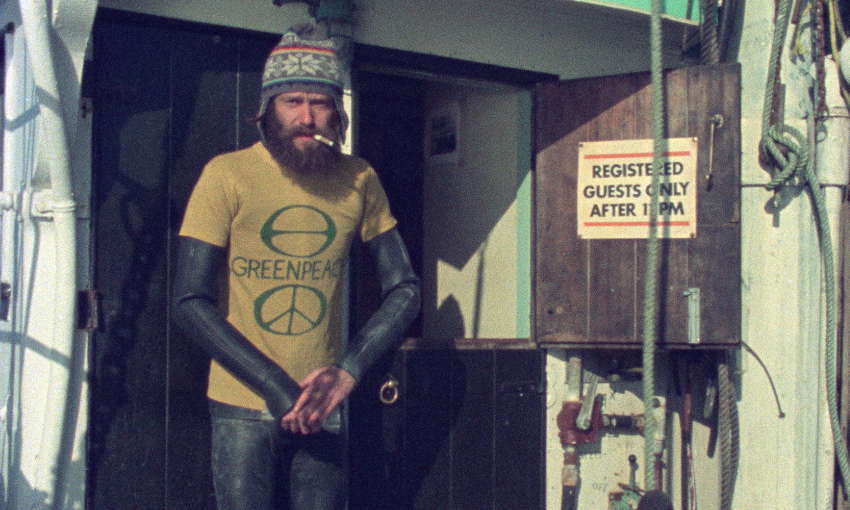
The context in which their actions took place is fascinating. Greenpeace are still media darlings and there’s still a great news story to be had sometimes from anti-whaling campaigns and things like that. But in the period your film covers, they dovetail really nicely with anti-Russian sentiment, for instance. And they were a novelty.
I hadn’t realised quite how much they’d come out of the Cold War, really, and as a response to the Cold War. And I think Vancouver was this extraordinary place where a number of circumstances happened that perhaps created Greenpeace. Greenpeace, had it been created anywhere else, would have been very different. Vancouver had, at the time, lots of Americans fleeing the Vietnam War, heading over the border. So they had a really big peace movement, and then they have the wilderness to the north, and the sea to the west, so they understand nature and boats. And they have Native American culture, which has a particular relationship with the land and with nature. And I think all of those things sort of boiled up together into Greenpeace at that moment. And I think you’re right: just the fact that they were going up against the Russians in anti-whaling campaigns gave them a lot of traction, I think, in America. Because apart from anything else, it was the realisation that hang on, here are these Russian boats packed with communications technology 50 miles off the coast. So, yeah, I think the Cold War was a really shaping factor, as it really defined the politics of that period anyway.
Obviously, so many years later, we’re really familiar with whaling footage, but that doesn’t stop it being striking imagery, especially when there’s a personal dimension to those folks going out on boats to try and prevent it. How much time did you spend working with that footage, and what was the impact on you of doing that?
Although I guess we had a pretty conventional length of an edit for a feature doc. It was kind of around six months, a bit less than six months; it was 22 weeks, I think. Yeah, those two really bloody sequences, the whale sequence and the seal sequence… The shot where the water is filled with blood, I think was the one of the first shots we scanned. Because some of this material wasn’t easy to look at. What I decided to do was, we would scan 20 hours of material, which was all the material within the period that we’re interested in, and work from there. And that was one of the first reels that we scanned. I don’t think I’ve ever seen anything like it. I think the reason perhaps is that maybe we’re used to footage that isn’t actually quite at water level. There’s something about actually being down at the level of the Zodiac, which I haven’t seen much recently, I think most recent footage tends to be from the bigger boats. And there’s something about being right down at that level of the water that’s very powerful.
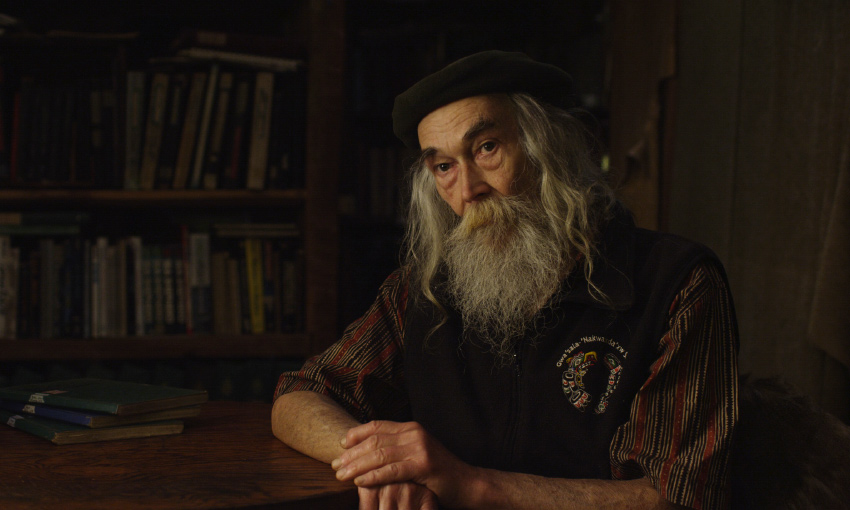
Part of why the film made such a strong impact on me was in taking grotesque things that are familiar, but it is a little bit like you’re seeing it for the first time with the film’s subjects.
There were a couple of dangers with the film. One was that it was just that they do the nuclear, then they do the whales, then they do the seals, and it was like just a succession of campaigns. Because I wanted the film to tell a story that went over a period of years, went from the first foundations to giving the movement away, if you want, or giving Greenpeace away. To really match the experience of that family group. But it was always a danger of like, it’s just going to be campaign after campaign, and how interesting is that? So it felt like that each campaign also had to express something about the way the group was developing and about the relationships between the individuals who were key to it. Which, in fact, I think they do. I think that’s historically true that each campaign shifted the dynamics between them and created a set of tensions that changed the way the group worked as well, as well as whatever they were campaigning about. But it took a while, I think. To begin with, I was thinking, “Should we try and do the whole film through the whale campaign?” There were all kinds of different options there. But in the end, those three key targets, I guess, were the ones to focus on.
I’d say there’s also a fourth, and that’s as the group turns on itself, and it’s kind of curious and not entirely unexpected. I don’t know, is it something that’s more confined to liberal organisations? To be prone to infighting?
I was thinking about it actually. Showing the film involves a lot of conversations about this issue. Particularly a part of those groups. I’ve spent a lot of time in my life in groups that try and function collectively in various ways, with housing groups or some political groups or whatever. And I think one of things that we really fail to understand in those groups is how movements always kind of plural; they’re always multifaceted. You put ten people in a room and get them to try and do something, and there’ll always be divisions between those who want to compromise in certain ways, or those who won’t compromise at all and want to do things really aggressively. In fact, any ten people will probably start to fragment along those lines because those things are just to do with action, to do with what happens when you decide to take an action. I don’t know if it’s specifically liberal groups, but I think it’s groups that have a ideological motive. I guess it’s particularly prone to that because the ideology can be used to justify the divisions that probably would have happened in the group anyway, you know what I mean? And that’s more bitter.
‘How to Change the World’ movie times















